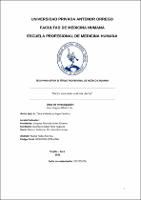Mostrar el registro sencillo del ítem
Factor asociados a atonía uterina
| dc.contributor.advisor | Núñez Rodas, Maritza | |
| dc.contributor.author | Távara Mendoza, Angie Carolina | |
| dc.creator | Távara Mendoza, Angie Carolina | |
| dc.date.accessioned | 2022-05-21T12:28:18Z | |
| dc.date.accessioned | 2022-05-21T12:28:20Z | |
| dc.date.available | 2022-05-21T12:28:18Z | |
| dc.date.available | 2022-05-21T12:28:20Z | |
| dc.date.issued | 2022 | |
| dc.identifier.uri | https://hdl.handle.net/20.500.12759/8964 | |
| dc.description.abstract | Determinar los factores asociados al desarrollo de atonía uterina en puérperas inmediatas, atendidas en el Hospital Regional Docente de Trujillo durante el período 2009-2019. Material y métodos: Se realizó estudio observacional analítico retrospectivo longitudinal, de tipo casos y controles, en el que se incluyeron a 4, 148 pacientes puérperas inmediatas atendidas en el Servicio de Obstetricia del Hospital Regional Docente de Trujillo en el período 2009-2019, de las cuales 1037 pacientes presentaron atonía uterina y 3111 fueron los controles. Se aplicó el odds ratio y la prueba estadística chi cuadrado, así mismo, se realizó un análisis multivariado con los factores significativos haciendo uso de la regresión logística. Resultados: Al realizar el análisis bivariado las variables que presentaron significancia estadística como factores asociados para el desarrollo de atonía fueron el embarazo múltiple [OR 4,48 (IC 95%: 3,43 – 5,83)], parto disfuncional [OR 1,82 (IC 95 %: 1,44 – 2,31), la vía de culminación del parto por cesárea [OR 1,98 (IC 95%: 1,71-2,29)], feto macrosómico [OR 1,37 (IC 95%: 1,08 – 1,73)] y el ser procedente de la sierra [OR 1,38 (IC 95 %: 1,12-1,70)]. Por otro lado, se mostraron como factores no asociados con significancia estadística, el ser multípara [OR 0,82 (IC 95%: 0,69 - 0,97)]. Conclusiones: Se comprobó que los factores asociados al desarrollo de atonía uterina en puérperas inmediatas, fueron el haber tenido embarazo múltiple, labor de parto disfuncional, la cesárea como vía de culminación del parto, el haber tenido un feto macrosómico y el ser procedente de la sierra. | es_PE |
| dc.description.abstract | To determine the factors associated with the development of uterine atony in immediate postpartum women, attended at the Regional Teaching Hospital of Trujillo during the period 2009-2019. MATERIAL AND METHODS: A longitudinal retrospective case-control observational analytical study was conducted, including 4,148 immediate postpartum patients attended in the Obstetrics Service of the Regional Teaching Hospital of Trujillo in the period 2009-2019 taking into account the inclusion and exclusion criteria, of which 1037 patients presented uterine atony and 3111 were the controls. The odds ratio and the chi-square statistical test were applied, likewise, a multivariate analysis was performed with the significant factors making use of logistic regression. RESULTS: When performing the bivariate analysis, the variables that presented statistical significance as risk factors for the development of atony were multiple pregnancy [OR 4,48 (IC 95%: 3,43 – 5,83)], dysfunctional birth [OR 1.82 (95% CI: 1.44 – 2.31)], the route of completion of cesarean delivery [OR 1,98 (IC 95%: 1,71- 2,29)], macrosomal fetus [OR 1.37 (95% CI: 1.08 – 1.73)] and being from the saw [OR 1,38 (IC 95 %: 1,12-1,70)].On the other hand, they were shown as factors not associated with statistical significance, being multiparous [OR 0,82 (IC 95%: 0,69 - 0,97)]. CONCLUSIONS: It was found that the factors associated with the development of uterine atony in immediate puerperal women were multiple pregnancies, dysfunctional birth, caesarean section as a way of culminating childbirth, macrosomal fetus and being from the saw. | en_US |
| dc.description.uri | Tesis | es_PE |
| dc.format | application/pdf | es_PE |
| dc.language.iso | spa | es_PE |
| dc.publisher | Universidad Privada Antenor Orrego | es_PE |
| dc.relation.ispartofseries | T_MED_3163 | |
| dc.rights | info:eu-repo/semantics/closedAccess | es_PE |
| dc.rights.uri | https://creativecommons.org/licenses/by/4.0/ | es_PE |
| dc.source | Universidad Privada Antenor Orrego | es_PE |
| dc.source | Repositorio Institucional - UPAO | es_PE |
| dc.subject | Factor Asociado | es_PE |
| dc.subject | Atonía Uterina | es_PE |
| dc.title | Factor asociados a atonía uterina | es_PE |
| dc.type | info:eu-repo/semantics/bachelorThesis | es_PE |
| thesis.degree.level | Título Profesional | es_PE |
| thesis.degree.grantor | Universidad Privada Antenor Orrego. Facultad de Medicina Humana | es_PE |
| thesis.degree.name | Médico Cirujano | es_PE |
| thesis.degree.discipline | Medicina Humana | es_PE |
| dc.subject.ocde | https://purl.org/pe-repo/ocde/ford#3.02.27 | es_PE |
| renati.advisor.orcid | https://orcid.org/0000-0001-6976-6766 | es_PE |
| renati.author.dni | 72948736 | |
| renati.advisor.dni | 18021995 | |
| renati.type | https://purl.org/pe-repo/renati/type#tesis | es_PE |
| renati.level | https://purl.org/pe-repo/renati/level#tituloProfesional | es_PE |
| renati.discipline | 912016 | es_PE |
| renati.juror | Vásquez Alvarado, Javier Ernesto | |
| renati.juror | Alcántara Ascón, Rene Augusto | |
| renati.juror | Alarcón Gutiérrez, Christian Giusseppe | |
| dc.publisher.country | PE | es_PE |
Ficheros en el ítem
-
Medicina Humana [2969]


